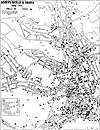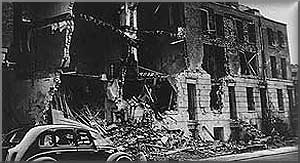The first bombs fell on the town on 6th
July 1940 and the first shell, fired from the long-range
guns built by the Germans on the cliffs of Calais, fell
on 12th August. Many of the remaining civilians took
shelter in caves deep within the cliffs.
Between July 1940 and September 1944 2,226 shells landed
on the town and 686 in the surrounding areas. Hundreds
more burst in the air or landed in the harbour. 464
high explosive bombs and three parachute mines fell
on the town.
3,059 air raid alerts were sounded in the town. A total
of 10,056 buildings were damaged, of which 957 were
destroyed and 2,914 severely damaged. 216 civilians
were killed, 344 severely injured and 416 slightly injured.
The last shell fell on Dover at 7:15pm on 26th September
1944, after which the guns at Calais were captured by
the advancing Allies and finally fell silent. On 18th
October King George VI and Queen Elizabeth visited the
town to pay tribute to Dover's fortitude throughout
more than four years of shelling and bombing.
|
|
Where the bombs and shells fell:

Click the map for a larger version.
|






